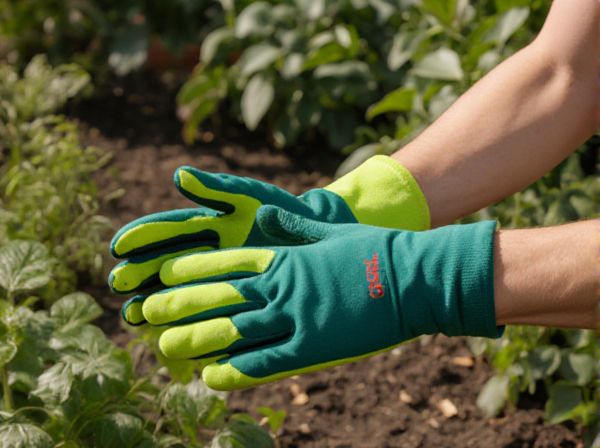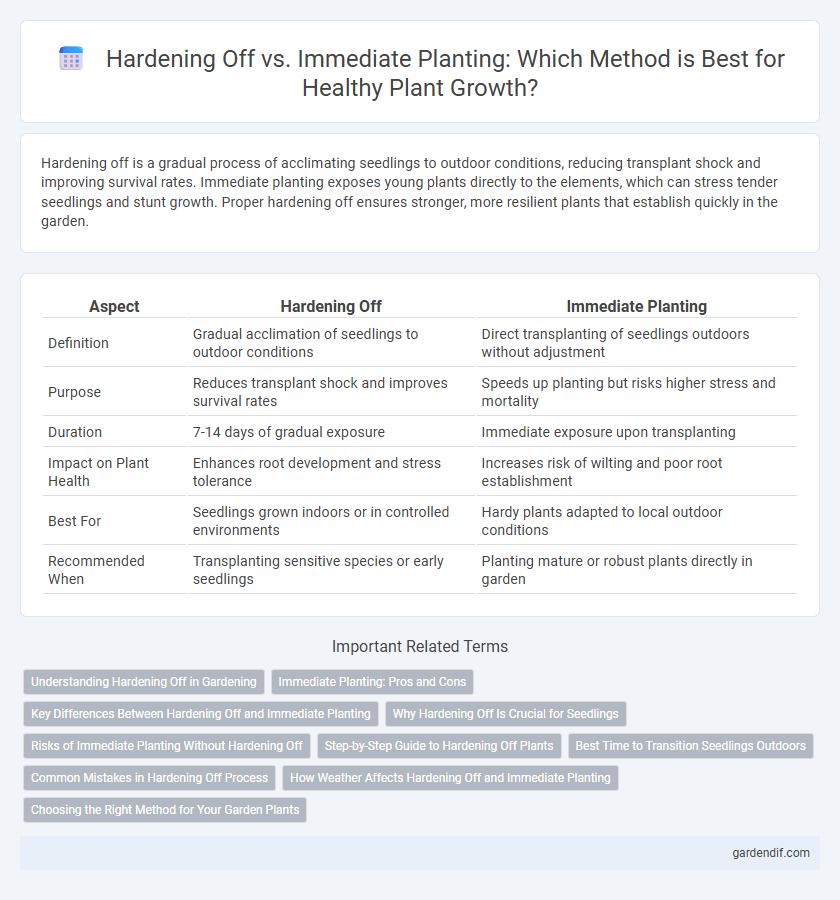
Hardening off vs Immediate planting Illustration
Hardening off is a gradual process of acclimating seedlings to outdoor conditions, reducing transplant shock and improving survival rates. Immediate planting exposes young plants directly to the elements, which can stress tender seedlings and stunt growth. Proper hardening off ensures stronger, more resilient plants that establish quickly in the garden.
Table of Comparison
| Aspect | Hardening Off | Immediate Planting |
|---|---|---|
| Definition | Gradual acclimation of seedlings to outdoor conditions | Direct transplanting of seedlings outdoors without adjustment |
| Purpose | Reduces transplant shock and improves survival rates | Speeds up planting but risks higher stress and mortality |
| Duration | 7-14 days of gradual exposure | Immediate exposure upon transplanting |
| Impact on Plant Health | Enhances root development and stress tolerance | Increases risk of wilting and poor root establishment |
| Best For | Seedlings grown indoors or in controlled environments | Hardy plants adapted to local outdoor conditions |
| Recommended When | Transplanting sensitive species or early seedlings | Planting mature or robust plants directly in garden |
Understanding Hardening Off in Gardening
Hardening off is a critical gardening technique that gradually acclimates seedlings to outdoor conditions by exposing them to increasing amounts of sunlight, wind, and temperature fluctuations over 7-14 days. Unlike immediate planting, which risks transplant shock and poor growth due to sudden environmental stress, hardening off strengthens plant cell walls and enhances resistance to pests and diseases. Understanding and applying hardening off improves transplant survival rates and promotes healthier, more vigorous garden plants.
Immediate Planting: Pros and Cons
Immediate planting allows seedlings to establish quickly in their permanent location, reducing transplant shock and speeding up growth cycles. However, it increases vulnerability to environmental stressors such as temperature fluctuations and pests, potentially hindering plant development. Careful selection of hardy species and optimal gardening conditions can mitigate these risks for successful immediate planting outcomes.
Key Differences Between Hardening Off and Immediate Planting
Hardening off involves gradually acclimating young plants to outdoor conditions by exposing them to sunlight, wind, and temperature changes over 7-14 days, reducing transplant shock and improving survival rates. Immediate planting places seedlings directly into the garden without transition, increasing the risk of stress due to sudden exposure to environmental fluctuations. Key differences include the timing and method of exposure to outdoor elements, impacting plant establishment and growth success.
Why Hardening Off Is Crucial for Seedlings
Hardening off seedlings gradually exposes them to outdoor conditions, enhancing their ability to withstand temperature fluctuations, wind, and direct sunlight, which reduces transplant shock. Immediate planting often leads to stress from sudden environmental changes, resulting in poor growth or seedling death. This acclimatization process strengthens plant cell walls and improves overall resilience, ensuring higher survival rates and healthier development.
Risks of Immediate Planting Without Hardening Off
Immediate planting without hardening off exposes plants to environmental stress such as temperature fluctuations, intense sunlight, and wind, leading to shock that can stunt growth or cause death. Transplant shock from sudden exposure reduces root establishment and nutrient uptake, increasing vulnerability to diseases and pests. Gradual acclimatization via hardening off strengthens plant resilience and improves survival rates in outdoor conditions.
Step-by-Step Guide to Hardening Off Plants
Hardening off plants involves gradually exposing seedlings to outdoor conditions over 7 to 10 days to strengthen them before permanent planting, reducing transplant shock and improving survival rates. Begin by placing seedlings outdoors in a shaded, sheltered area for a few hours, then increase exposure to sunlight and wind each day while limiting watering to encourage resilience. Immediate planting skips this acclimation process, often leading to stress and poor establishment, making hardening off a critical step for optimal growth and development.
Best Time to Transition Seedlings Outdoors
The best time to transition seedlings outdoors through hardening off is when daytime temperatures are consistently above 50degF (10degC) and nighttime lows remain near 45degF (7degC). Gradually exposing seedlings to outdoor conditions over 7-10 days strengthens their resilience, reduces transplant shock, and improves survival rates compared to immediate planting. Ignoring the hardening-off process risks stunted growth and increased vulnerability to pests, temperature fluctuations, and harsh sunlight.
Common Mistakes in Hardening Off Process
Common mistakes in the hardening off process include exposing seedlings to harsh sunlight or cold temperatures too quickly, which can cause stress and stunt growth. Neglecting gradual acclimation by skipping incremental outdoor exposure days often leads to shock when plants are suddenly planted outside. Overwatering or underwatering during hardening off periods disrupts moisture balance and reduces transplant success rates.
How Weather Affects Hardening Off and Immediate Planting
Cold temperatures and fluctuating weather conditions can stress seedlings during immediate planting, increasing the risk of transplant shock and stunted growth. Hardening off gradually exposes plants to outdoor elements like wind, sun, and temperature changes, enhancing their resilience and improving survival rates. Optimal weather for hardening off includes mild, calm days with gradual cooling, which helps plants adapt before permanent outdoor transplantation.
Choosing the Right Method for Your Garden Plants
Hardening off involves gradually exposing young plants to outdoor conditions, reducing transplant shock and improving survival rates, whereas immediate planting places seedlings directly into the garden, risking stress from abrupt environmental changes. Selecting the proper method depends on the plant species, climate, and timing, with cold-sensitive or tender plants benefiting most from hardening off processes. Ensuring optimal growth and development requires understanding these methods to enhance plant resilience and establishment in your garden.
Hardening off vs Immediate planting Infographic

 gardendif.com
gardendif.com